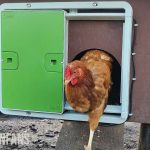Infectious Bronchitis in Chickens


Chickens that cough, sneeze, and produce pale, deformed eggs might suffer from Infectious Bronchitis. It’s a very common and widespread disease that spreads quickly through the flock. It’s caused by a coronavirus, should we be worried?
Let’s see what the disease looks like, how it spreads, and what you can do to prevent it.
- What is Infectious Bronchitis?
- Symptoms of Infectious Bronchitis
- Transmission
- Vaccination
- Treatment
- Infectious Bronchitis Virus
- Hyperimmunized Laying Hens in the fight against SARS-CoV-2
- Summary
What is Infectious Bronchitis?
Infectious Bronchitis is a contagious viral disease caused by a coronavirus that affects chickens of all ages. It’s primarily an upper respiratory disease but can spread to organs like the kidneys and the reproductive tract, where the ovary fills with fluid.
The virus is airborne and spreads quickly through the flock. Birds are coughing, sneezing, and rattling. Since it’s a viral infection, antibiotics won’t help fight the disease but can prevent secondary infections with bacteria.
The virus is also called the Avian Coronavirus, and the disease is sometimes referred to as a cold.
Symptoms of Infectious Bronchitis
The virus starts as an upper respiratory disease, infecting the windpipe of a chicken.
The first symptoms include:
- difficulty breathing
- nasal discharge and sneezing
- gurgling and rattling sounds in the windpipe
- eye inflammation, frothy, watery eyes with foamy bubbles
The gurgling sounds result from abundant white mucous and fluids in the windpipe.

Depending on the strain, multiple organs can be involved
- kidney inflammation (nephritis)
- inflammation of the reproductive organs, where the ovary is filled with fluid
- inflammation of the guts
Birds that are weakened by Infectious Bronchitis are prone to develop secondary diseases.
Impact of Infectious Bronchitis on Egg Laying
When the virus spreads to the reproductive system, the ovary fills with fluid, and the infection significantly affects the quality of the eggs. The Infectious Bronchitis Virus influences chemicals in the magnum, the organ responsible for egg white generation.

This malfunctioning results in distorted egg membranes that, in their turn, disrupt eggshell mineralization in the uterus or shell gland. Therefore a typical symptom is thin-shelled or even soft shell eggs.
- light, pale eggs with fewer pigments
- deformed, wrinkled eggs that are thin-shelled or soft shell eggs
- watery albumin (egg white)
- reduced egg production
When the virus affects younger pullets, it can cause permanent damage to the oviduct. Some will develop ovarian cysts that occupy space and impact egg-laying when they start laying. In adult hens, it’s merely a sudden drop in egg production.
Infectious Bronchitis is known to alter brown eggshell colors in laying hens. Brown eggs get their color from protoporphyrin pigments. These pigments are added as a layer of paint on the eggs in the last stages of the eggshell formation. Infectious Bronchitis disrupts the pigment deposition, which results in lighter, pale eggs and shell reflectivity. Shell color might even differ between vaccinated and unvaccinated birds.
Diagnosis and Diseases With Similar Symptoms
Unfortunately, diagnosing Infectious Bronchitis is difficult by just looking at clinical signs.
The symptoms of Infectious Bronchitis are very similar to other respiratory diseases, such as:
- Chronic Respiratory Disease – a bacterial infection, also known as mycoplasmosis
- Infectious Coryza – another widespread contagious bacterial infection
- Infectious Laryngotracheitis – a viral infection caused by the herpes virus
- Fowl Cholera – a bacterial disease that turns chicken combs purple
- Newcastle Disease – a viral infection with the Newcastle Disease virus
- Avian influenza – a viral infection with the influenza virus
- Vitamin A Deficiency – a shortage of vitamin A
For a correct diagnosis, an ELISA or RT-PCR test is required. In postmortem examination, the trachea clearly shows thick, yellowish mucoidal fluid, a clear indication of Infectious Bronchitis in poultry.
Transmission
The Infectious Bronchitis Virus can spread in multiple ways:
- via direct contact with infected chickens, infected feed, dead birds, or rodents
- via air droplets when a chicken sneezes or couches
- via virus in the droppings or dirt on the eggs of infected birds
Some sources cite airborne transmission can exceed half a mile (1km). The morbidity of Infectious Bronchitis is 100%, and it will disturb all the birds once it enters the flock.
The virus can be transmitted to the egg, but eggs with infected embryos generally don’t hatch, or chicks die in their first days.
Chickens may still shed the virus for two to three weeks after fully recovering. Outside the body, it’s not a particularly strong virus, as disinfectants and sunlight can easily eliminate it. Inside the body, the virus can survive, and birds can become carriers after recovery. The virus can pop up again when birds are under stress, for example, in chicken coops with improper ventilation.
Is Infectious Bronchitis in Chickens Contagious to Humans?
No, Infectious Bronchitis Virus (IBV) in chickens is not contagious to humans. The virus only affects birds, and IBV is the only strain of the avian coronavirus that infects chickens. Although IBV is a gammacoronavirus, it should not be confused with the gamma variant of SARS-CoV-2 that causes COVID-19 in humans.

Vaccination
Vaccination is available and commonly applied with both live and inactivated vaccines. Live vaccines are weakened but will still cause some light respiratory issues.
The vaccines can be administered via drinking water, eye drops, or sprays for large flocks. Day-old chicks are vaccinated after hatching, protecting them against circulating viruses in the first weeks of their lives. They get a booster vaccine two weeks after hatching (14th day).
Most commercial laying hens in the poultry industry are vaccinated against Infectious Bronchitis.
Treatment
Infectious Bronchitis is a viral disease and can not be treated with antibiotics. However, antibiotics are usually applied to prevent secondary infections, which are very common.
Since the virus is so contagious and spreads rapidly, it’s almost impossible to prevent its spread in the flock. An infected flock should be kept apart from neighbors’ flocks with proper biosecurity applied.
Treatment mainly consists of supportive measures and providing a healthy environment for the chickens:
- provide proper ventilation, clean air, and draught-free chicken coops
- avoid any ammonia fumes or toxic gas in or outside the coop
- optimal temperatures and temperature regulation if needed
Some sources report that increasing the temperature by a couple of degrees helps recovery. However, higher temperatures can sometimes inflict other health issues and dehydration.
Infectious Bronchitis Virus
The Infectious Bronchitis Virus is an avian coronavirus, and it’s the only coronavirus that causes Infectious Bronchitis in chickens. Another strain of the avian coronavirus infects turkeys, the Turkey coronavirus.
The Infectious Bronchitis Virus belongs to the broader group of Gammacoronaviruses. These viruses have their viral loads in single-stranded RNA. The RNA resides in a viral envelope that contains proteins. The coronavirus S proteins are glycoproteins. They allow the virus to attach to the chicken’s windpipe and infiltrate the cells.

Some coronaviruses attack humans, like the SARS-CoV-2 coronavirus that causes COVID-19. However, the avian gammacoronavirus is not to be confused with the gamma variant of the SARS-CoV-2 coronavirus. The human SARS-CoV-2 coronavirus is a Betacoronavirus and resides in a group other than the Infectious Bronchitis Virus.
Hyperimmunized Laying Hens in the fight against SARS-CoV-2
With the human coronavirus continuously adapting, scientists are searching for efficient ways to generate vaccines. The emergence of new variants reduces the effectiveness of vaccines based on the original S-spike proteins.
The fact that a chicken’s immune system reacts against coronaviruses like Infectious Bronchitis can play a vital role in developing COVID antibodies. In 2022, scientists vaccinated laying hens with multiple COVID vaccines to create hyperimmunized hens. The laying hens won’t develop Infectious Bronchitis or COVID after vaccination, but their immune system generates neutralizing antibodies that recognize the S-glycoprotein.
These antibodies in chickens come in the form of immunoglobulin (IgY). As it happens, IgY is analogous to human antibodies (IgG).
Every egg from hens in the study contains about 50 to 100mg IgY, which contains about 2-10% specific antibodies. The number of antibodies in the egg depends on the laying hen’s breed, age, and environmental factors. Using chicken eggs for COVID antibody generation is a cost-effective strategy that’s easily scalable.
The study also notes that virus neutralization did not occur in chickens already vaccinated for Infectious Bronchitis. This indicates that there is no cross-reaction between Infectious Bronchitis antibodies and SARS-CoV-2.
Summary
Infectious Bronchitis is a widespread, contagious viral disease that targets the upper respiratory tract. Once a bird becomes infected, the virus can spread to several organs, such as the kidneys (nephritis), guts, and reproductive tract, filling the ovary with fluids.
Infected chickens sneeze, cough, and have difficulty breathing while making rattling sounds. These symptoms are very similar to the symptoms of other common respiratory diseases.
Egg-laying hens will suddenly produce fewer eggs and lower quality. They can be deformed, thin, or soft shell eggs. Brown-shelled eggs look pale and lack pigment.
It’s possible to vaccinate, but it’s challenging to prevent the disease as it will rapidly spread through the flock. However, antibiotics can help prevent secondary infections.

Dr. Abrir A. is a licensed veterinarian with many years of experience on poultry farms and poultry feed. He has published several scientific articles on poultry diets, amino acids, and prebiotic usage in poultry. Dr. Ibrar is currently pursuing a Ph.D. in animal nutrition and nutritional diseases.























